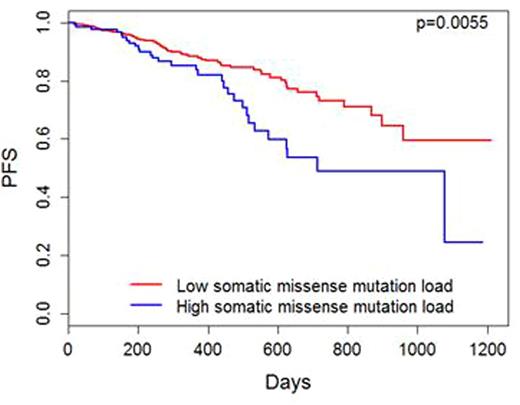Abstract
Introduction
Tumor specific somatic mutations can potentially influence patient response to targeted immunotherapies. Since somatic mutations generate neoantigens, novel tumor-specific peptides can be processed, loaded into MHC class I molecules, and presented to T-cells as potentially immunogenic targets. Indeed, both somatic mutation burden and neoantigen burden have been correlated with responsiveness to checkpoint inhibitor blockade in highly mutagenic advanced melanoma and lung cancer. However, correlation of response with mutation and neoantigen burden has not been reported for cancers of lower characteristic mutational burden such as multiple myeloma (MM). Indeed early results of checkpoint inhibitors in MM have been underwhelming. We therefore wished to better understand the mutation and neoantigen landscape of MM patients as it relates to responsiveness to current and future therapies.
Materials/Methods
Somatic mutation burden, neoantigen load, and response to therapy was obtained using interim data from theCoMMpassstudy (NCT01454297), a study by the Multiple Myeloma Research Foundation that collects longitudinal clinical and molecular data on 1,000 newly diagnosed MM patients from baseline through treatment and disease progression. Next-generation exome sequencing data was used to call somatic mutations andbioinformaticallydetermine patient specific HLA type. Neoantigen binding affinity was predicted for all unique patient specific somatic missense mutation and HLA allele combinations using a well validated neural network and machine learning based algorithm. Binding affinity of the corresponding non-mutated peptide was also predicted to identify mutated neoantigens witha high binding affinity while the wild type counterpart has low predicted binding affinity.
Results
For 627 patients with available sequencing and clinical data, mutation and neoantigen profiles were created. Within this population, the mean overall canonical somatic mutation load was 405.84 (s=608.55) mutations per patient. These mutations included 38,222 unique missense mutations in 12,994 genes. The mean somatic missense mutation load was 64.51(s=95.29) mutations per patient including immunoglobulin genes (52.70, s=94.85 excluding immunoglobulins). There was a positive linear correlation between mutation burden and neoantigen burden. The mean neoantigen load using thresholds of mutant peptide binding affinity (half maximal inhibitory concentration, IC50) less than 500nM was 69.57 (s=124.76) neoantigens (58.53, s=123.58 excluding immunoglobulins). Limiting binding affinity of wild type peptide sequence to greater than 500nM decreased the mean neoantigen load to 23.84 (s=53.55) neoantigens (20.74, s=53.28 excluding immunoglobulins).
Progression free survival (PFS) following induction therapy was used to determine correlates of mutation burden excluding immunoglobulin mutations with response. Kaplan-Meier survival analysis revealed significantly shorter PFS time in patients with greater than average tumor somatic missense mutation load (N=126) relative to those with less than average mutation load (49.1% vs. 73.0% PFS at 2yrs, p=0.0055, Figure 1) Similarly, patients with greater than average neoantigen load (N=164) had significantly shorter PFS relative to those with less than average neoantigen load (48.0% vs. 74.2% PFS at 2yrs, p=0.00259, Figure 2). Moreover, patients with both high mutation and neoantigen load (N=85) had significantly shorter PFS relative to those with less than average mutation and neoantigen load (45.3% vs. 72% PFS at 2yrs, p= 0.0168).
Conclusion
While mutation and neoantigen load has been correlated with response to targeted immunotherapies in highly mutated solid tumors, we report here a negative correlation between mutation, neoantigen load and MM patient survival. This indicates that a high mutation andneoantigen load negatively impacts survival of myeloma patients under current standard of care. It is hypothesized that this is because current treatments fail to recruit T cell immunity necessary to exploit tumor neoantigens fundamental to immune-mediated killing of cancer cells. This presents an encouraging basis for pursuing targeted and personalized immunotherapies for multiple myeloma, especially for patients with a higher mutational burden.
PFS and mutation load.
PFS and neoantigen load.
Lonial:BMS: Consultancy; Celgene: Consultancy; Janssen: Consultancy; Onyx: Consultancy; Celgene: Consultancy; Novartis: Consultancy; Janssen: Consultancy; Onyx: Consultancy; Novartis: Consultancy; BMS: Consultancy; Millenium: Consultancy; Merck: Consultancy.
Author notes
Asterisk with author names denotes non-ASH members.



This feature is available to Subscribers Only
Sign In or Create an Account Close Modal